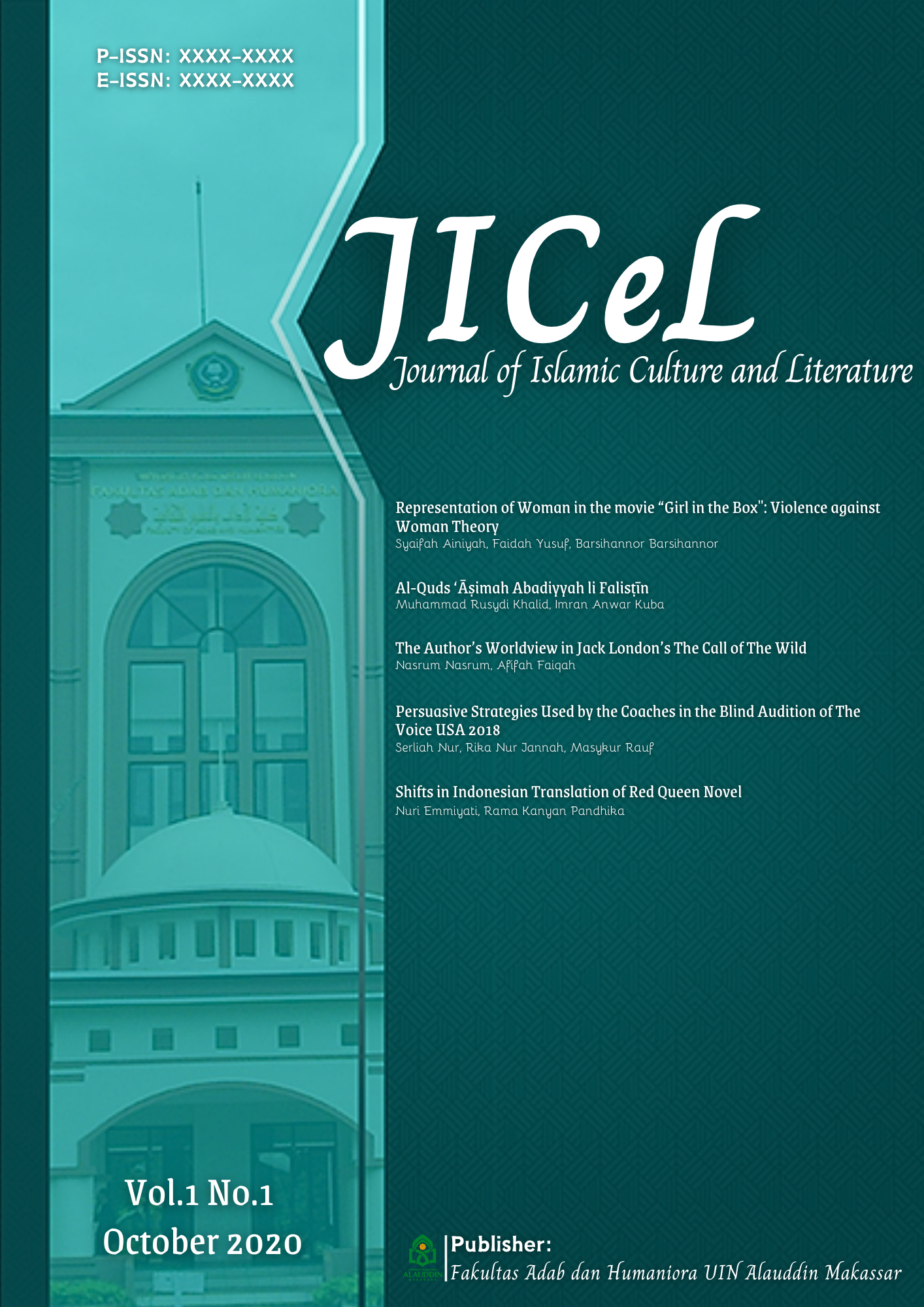Representation of Woman in the movie “Girl in the Box": Violence against Woman Theory
Abstract
This article is about Representation of Woman in the movie “Girl in the Box”: Violence against Woman Theory. The researcher used a descriptive qualitative analysis of violence against women from Linda Bickerstaff, which is analyzing a scene of dialogue and image. This study has shown that girl in the box presents women as the leading character who dealt with injustice. The results of analysis of women have been represented as weak and defenseless women to be the victims of physical, emotional, sexual, psychological and economical violence: spreading fear, assaults on physical action, threats, coercion of sexual relations, sexual abuse, and a sense of helplessness and a lack of confidence. This study led to the conclusion that women were pandered to as exploiting women and women's lib rates. Women tend to be yielding, weak, cry, and dominate men.References
Bickerstaff, Linda 2010. Violence Against Women: Public Health and Human Rights. New York: The Rosen Publishing Group, Inc.
Bogdan, R, C, Biklen, S.K. 1982. Qualitative research for education: An Introductoin to Theory and Methods. Boston: Allyn and Bacon, Inc.
Hall, Stuart,“The Work Of Representation.” Representation: Cultural Representation and Signifying Practice. Ed. Stuart Hall. (London: Sage Publication, 2003.
Hartly, Jhon, Communication, cultural and Media Studies: Konsep Kunci Yogyakarta: Jalasutra, 2010. http://tafsir.com/4-an-nisa/ayat-19
Irfani, Bunga, “Modul Mata Kuliah Produksi Siaran Televisi” Unsur-Unsur Cerita yang Baik”, Yogyakarta: Fakultas Dakwah dan Komunikasi, 2004.
Jarjie, Anastasia’s Struggle Against Grey’s Violence In E.L James’ Fifty Shades Of Grey. ( Thesis: Maulana Malik Ibrahim State Islamic University Of Malang, 2016)
Jones, Roderick. 2002. Conference Interpreting Explained. Manchester: St. Jerome Publishing.
Kennedy, X. J. 1991. Literature in Introduction to Fiction, Poetry and Drama. New York: Haper Collins Publisher, Inc.
Mc Quail, Denis, Teori Komunikai Massa, Terj., Jakarta: Salemba Humanika, 2011.
Murray A. Straus, Richard J. Gelles. 1990. Physical violence in American Families: Risk Factors and Adabtations to Violence in 8.145 Fmilies. New Brunswick, New Jersey: Trasaction Publishers, Inc.
Nancy A. Crowell, Ann W. Burgess. 1998. Understanding Violence Against Women. Washinton, D. C: National Academy Press.
Nugriantoro, Burhan, Teori Pengkajian Sastra, Yogtakarta: Gajah Mada University Press, 2007.
Nur, Hardianti. H. M,Violence Toward Women in Stieg Larsson’s Novel “The Girl With The Dragon Tattoo”( Thesis: State Islamic University of Makassar, 2013)
Pratista, Himawan, 2008. Memahami Movie. Yogyakarta: Homerian Pustaka
Rohman, Moch Vathur, Representasi Kekerasan Terhadap Perempuan Dalam Movie Harim di Tanah Haram (Analisis Semiotika Pada Tokoh Qia), Skripsi, Yogyakarta: Fakultas Dakwah dan Komunikasi UIN Sunan Kalijaga, 2017.
Sihite, Romany, Perempuan, Kesetaraan, & Keadilan: Suatu Tinjauan Berwawasan Gunder, Jakarta: PT Raja Grafindo Persada, 2007.
Sobur, Alex, Analisis Teks Media: Suatu Pengantar untuk Analisis Wacana, Analisis Semiotika, dan Analisis Framing, Bandung: PT. Remaja Rosdakarya, 2004.
UU Nomor 23 tahun 2004 tentang penghapusan kekerasan dalam Rumah Tangg
Authors who publish with this journal agree to the following terms:
1) Authors retain copyright and grant the journal right of first publication with the work simultaneously licensed under a Creative Commons Attribution License that allows others to share the work with an acknowledgement of the work's authorship and initial publication in this journal.
2) Authors are able to enter into separate, additional contractual arrangements for the non-exclusive distribution of the journal's published version of the work (e.g., post it to an institutional repository or publish it in a book), with an acknowledgement of its initial publication in this journal.
3)Authors are permitted and encouraged to post their work online (e.g., in institutional repositories or on their website) prior to and during the submission process, as it can lead to productive exchanges, as well as earlier and greater citation of published work (See The Effect of Open Access).


